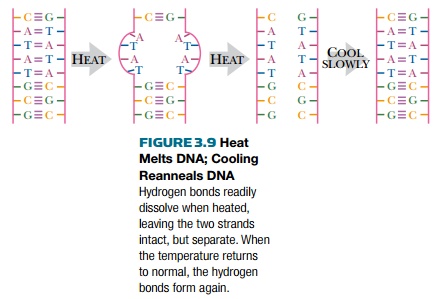Chapter: Biotechnology Applying the Genetic Revolution: Recombinant DNA Technology
Complementary Strands Melt Apart and Reanneal
COMPLEMENTARY
STRANDS MELT APART AND REANNEAL
The complementary
antiparallel strands of DNA form an elegant molecule that is able to unzip or melt and come back together or reanneal (Fig. 3.9). The hydrogen bonds
that

hold the two halves together
are relatively weak. Heating a sample of DNA will dissolve the hydrogen bonds,
resulting in two complementary single strands. If the same sample of DNA is
slowly cooled, the two strands will reanneal so that G matches with C and A
matches with T, as before.
The proportion of G-C base
pairs affects how much heat is required to melt a double helix of DNA. G-C base
pairs have three hydrogen bonds to melt, whereas A-T base pairs have only two.
Consequently, DNA with a higher percentage of GC will require more energy to
melt than DNA with fewer GC base pairs. The GC ratio is defined as follows:

The ability to zip and unzip
DNA is crucial to cellular function, and has also been exploited in
biotechnology. Replication and
transcription rely on strand separation
to generate either new DNA or RNA strands, respectively. In molecular biology
research, many techniques, from PCR to library screening, exploit the
complementary nature of DNA strands.
Related Topics